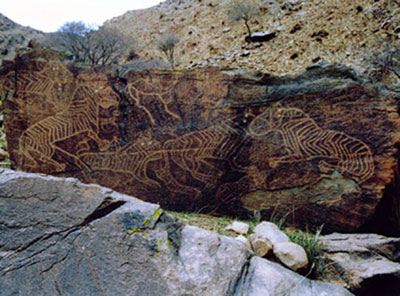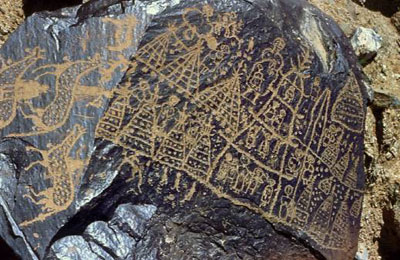As early as the 5th century, the rock paintings of Yinshan
Mountains were found by Li Daoyuan, a geologist of the Northern Wei
Dynasty. A detailed account of his findings was given in his
renowned Work-Commentary on the Waterways Classic. This is the
earliest record of the rock paintings of Yinshan Mountains in the
world. It was in 1976 that China started a comprehensive survey of
the rock paintings. From then on, large numbers of experts,
scholars and tourists have carried out studies of these paintings
and paid visits to Bayannur League, more than ten thousand rock
paintings have been discovered, and nearly one thousand of them
have been photographed or copied. These rock paintings not only
reflect the beliefs, aesthetic standards and world outlook of the
ancient in habitations in Yinshan Mountains areas, but also present
a truthful picture of their nomadic life.
 |
The rock paintings of Yinshan Mountains scatter over a wide
area. The densest concentration is on the Heishan Mount of Dilihari
Mountains to the south of Wulate Middle Banner, Bayannur League,
Inner Mongolia, stretching over five kilometers from the east to
the west. Over one thousand rock paintings can be found in this
place alone. These rock paintings, together with the large numbers
of rock paintings found on the southern hillside and the
mountaintop not too far away to the northeast of the Dilihari
Mount, constitute a concentration area of rock paintings. On the
Wayaogou Northern Mount about 8 kilometers to the southwest of the
Dilihari Mount, paintings can be found at the intervals of 2
meters, 10 meters or longer, amounting to a total number of more
than 900 paintings. Next in density is the black rocks in the
mountainous areas of North Tuolin Valley, Dengkou County, where
rock paintings are found at the intervals of2-3meters ingeneral and
10 meters at the most, numbering more than 500 pieces in total.
One of the two densest concentrations of rock painting group is
a cliff facing the north in Molehetu Valley, with about 80 head
portraits clustered within an area approximately 50 meters in width
and 20meters in height. The other one is a cliff facing the west in
the middle of Geheshangde Valley, consisting of 50 individual
drawings within an area approximately 5 meters in width and 15
meters in height.
The rock painting with the largest sizes the square painting
drawn on the rocks by the western mouth of the Daba Valley, Urad
Rear Banner, which covers an area of about 400 sq meters and ranks
among the key preserved cultural relics of Inner Mongolia
Autonomous Region.
 |
The themes of the rock paintings are in general the hunting
activities of the nomadic nationalities. Among the rock paintings,
the most numerous and most finely drawn ones are pictures of
animals, including goats, sheep, argali, antelopes, blue sheep,
elks, white-lipped deer, cervus elaphus, David's deer, moose (also
known as han da an), roe deer, horses, mules, donkeys, camels,
oxen, wild oxen, takins, dogs, turtles, wild boars, rabbits, foxes,
snakes, wolves, tigers and leopards, etc. Scenes of hunting, with
their considerable amounts and representation of the social life of
the prehistoric nationalities, also hold a special position and
constitute the most magnificent part of the rock paintings. Scenes
of hunters, weapons and ways of hunting are depicted in these
paintings.
Certain rules were followed in the themes and distributions of
the rock paintings of Yinshan Mountains-drawings of wild animals
are found mostly on rocks on mountaintops, scenes of hunting
generally half way up the mountains while head portraits of gods,
celestial bodies and constellations mostly engraved on steep cliffs
in valleys or on giant rocks on hillsides by valleys (primitive
people believed that gods lived in places of swift currents). These
rules are in conformity to the social environment in which the
paintings were drawn and the ideologies held by people then.
The rock paintings of Yinshan Mountains are plain and vivid in
their artistic features and full of rich flavor of life. The rock
paintings are mostly based on realistic depictions and present a
record of the social life of the childhood and the early historical
stages of human beings. Prominence was given to the images of
winners in terms of compositions and proportions, creating strong
artistic effects.
The rock paintings of Yinshan Mountains were drawn mostly by
either chiseling or grinding. By chiseling method, metal or stone
tools with greater hardness than the rocks were used to chisel and
dig tiny spots on the rocks, which were then connected to make
outlines of the drawings. Rock paintings drawn by chiseling are
uneven in depth and density. The paintings drawn by grinding, also
known as abrading, are characterized by deeper marks, polished
surfaces and U-shaped sections. Apart from these two methods, there
is also the scratching method that produced thin and more
superficial lines. Works drawn by scratching are mostly of later
periods.
Paintings drawn on rocks with the mixture of lime and animal and
vegetable oils, known as colored rock frescoes, can also be found.
Paintings of this kind are small in number, mostly of the more
recent periods and connected with Lamaism.
The rock paintings of Yinshan Mountains can be divided into
groups of four ages and five periods:
Paintings of the first age are the works of primitive clan
tribes of the period from the late Paleolithic Age to mid Bronze
Age. Rock paintings in this period are in a period of prosperity
with their large numbers, wide distributions and delicate
craftsmanship.
The rock paintings of the second age are those drawn by the Hans
during the period from the Spring and Autumn Period to the Western
and Eastern Han dynasties.
Rock paintings of the third age are referred to as paintings of
the Middle Ages. Paintings of this age can be further divided into
two groups---the rock paintings of the Turk from the Northern
Dynasty to the Tang Dynasty and those of the Outgoes and the Tangos
from the Five Dynasties to the Song Dynasty. The rock paintings of
the Turk are small in number and themes mainly with domestic
animals with goats in the dominant place. Abstractionism and
symbolism were employed as techniques of expression in these
paintings. The paintings of the Outgoes are characterized by lines
drawn with iron tools, thin and superficial outlines, imitation of
preceding works in themes and occasional designs of plants and
scripts of the language of the Outgoes. The rock paintings of the
Tangos are mostly drawn by chiseling, usually rough in
craftsmanship while fresh in color and seemingly new in appearance,
with inscriptions of the language of the Western Xia Dynasty.
Rock paintings of the fourth age are works of the Mongolians
after the Yuan Dynasty and are known as the rock paintings of the
recent times. They consist of chiseled paintings and colored ones.
The colored rock paintings are unique to the Mongolians. Apart from
some themes of the life and production activities (for example,
galloping horses, two-humped camels, herdsman, etc.), most of the
paintings are designs related to Lamaism.